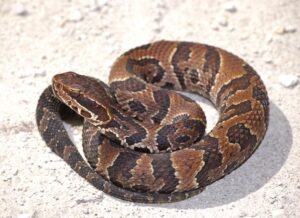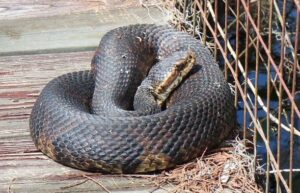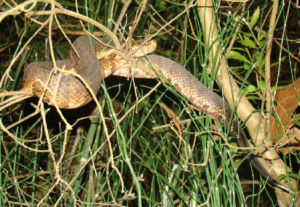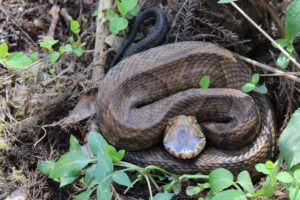Cottonmouth / Water Moccasin (Agkistrodon piscivorus)
Updated on
25/04/2024The cottonmouth is one of the few semi-aquatic venomous snakes worldwide. They are named cottonmouth as the insides of their mouth, visible when they gape at their prey, are white. These snakes are indigenous to the Southeastern United States and are also called water moccasins as they prefer living in water for a long time.
Though listed as venomous snakes they are not aggressive and attack only when agitated. According to the records of the University of Florida the cottonmouths are responsible for 1% of the deaths from snake bites in the United States every year.
Scientific Classifications
- Suborder:Serpentes
- Family:Viperidae
- Genus:Agkistrodon
- Species:A. piscivorus
Conservation Status
Subspecies
The cottonmouth had three recognized subspecies for many years – the eastern cottonmouth (A. p. piscivorus), western cottonmouth (A. p. leucostoma), and Florida cottonmouth (A. p. conanti). After the 2014 DNA-based molecular study, this taxonomy changed, and the cottonmouth has no current subspecies.
The eastern and western cottonmouth is considered a single species as no genetic difference is found between them. The Florida cottonmouth native to Florida and south Georgia was considered a separate species and assigned the specific name Agkistrodon conanti.
Description
Size
The average length of adult water moccasins is between 26 and 35 inches (65-90 cm). Cottonmouths living in the eastern range – Georgia, North Carolina, South Carolina, and southeast Virginia may grow more than 71 inches (180cm) and can weigh as much as 10lb (4.6 kg).
The male moccasins are bigger and heavier than the females, weighing 10 to 20 oz (283 to 567 grams). The females weigh around 8 to 9 oz (226 to 255 grams)
Color and Appearance
Most cottonmouths are black, though some specimens can vary from brown to gray and tan to yellowish-olive. The 10-17 black or brown crossbands on their body may form a continuous pattern or break along the dorsal midline as irregular halfbands. The bands are lighter at the center, closely merging with the background color and fading with age.
Their belly is either wholly white or yellowish-white and marked with dark brown or yellowish-brown blotches forming an impressive pattern.
The juvenile and subadult cottonmouths have a brighter appearance with a brown, tan, or reddish-brown body.
The juveniles have yellow tail tips that change to greenish or greenish-yellow in subadults. When they reach the adult stage, the tail tips turn entirely black.
Besides their vivid coloration, they also have an intimidating appearance due to their prominent physical features like a broad, triangular-shaped head, elliptical pupils, prominent jowls, blunt snouts, and keeled scales.
Both sexes have 23 to 27 dorsal scales though the number of ventral scales differs, 130 to 145 in males and 128 to 144 in females.
They have heat-sensing pits near the eyes and nostrils, which help detect temperature differences more accurately.
Are they Dangerous to Humans
Do they bite
They bite when threatened or disturbed. Studies deduce that these snakes become compelled to strike when they get violent.
Are their bites dangerous
Their bite can be fatal since they have potent venom containing hemotoxins that destroy the RBCs and prevent blood clotting. It can take a few minutes to a couple of hours for the symptoms to become prominent. Immediate medical attention is needed lest the symptoms could get severe and life-threatening.
In 2015 a man in Missouri died after being bitten by a venomous snake (possibly the cottonmouth).
The survival rate from a cottonmouth bite is high. Of the 255 cottonmouth envenomation reported to the poison center in the U.S., 10 were serious, and there were 0 cases of fatalities.
Cottonmouth Snake at a Glance
Distribution
They are found throughout the United States in southeast Virginia, around the Great Dismal Swamp region. These snakes also inhabit the Florida peninsula, northern and southern Illinois, Indiana, Oklahoma, Arkansas, Central Texas, and West Texas, Middle Tennessee, West Tennessee, Southeast Kansas, and west Kentucky.
Habitat
They live near water sources like marshes, streams, canals, lakes, and retention ponds. The cottonmouths prefer freshwater habitats but can sometimes be found in brackish water.
In locations like East Texas and Florida, they have adapted to less moist surroundings like pinewoods and pine flatwoods.
Lifespan
They can live for 10 years in the wild and around 24 years in captivity.
Predators
Their predators include the snapping turtle, American alligator, falcon, eagle, horned owl, red-shouldered hawk, loggerhead shrikes, cranes, egrets, and heron. They are even preyed upon by other snakes like the eastern kingsnake.
Diet
The cottonmouths feed on mammals, amphibians, birds, fish, small alligators, turtles, and other snakes. They are cannibalistic and opportunistic feeders who do not hesitate to feed on carrion.
The quadrate bones lying between the lower jaw and skull are longer in males. So, they can consume taller prey than females of similar size, as shown in studies.
In 2022, a 42-inch cottonmouth attacked and ate a 39-inch Burmese python with a tracker attached.
Reproduction
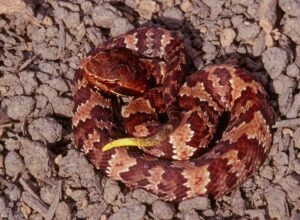
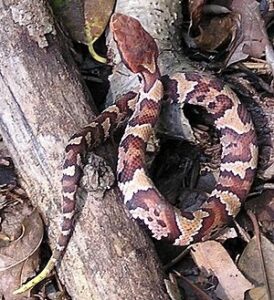
The mating season starts in summer when males battle it out to seek a prospective mate. The cottonmouths are ovoviviparous, and the females can produce between 1 and 16 live young every 2-3 years, 20 being the maximum number. The average litter size comprises 6-8 snakelets.
The neonates are 9-14 inches (22 – 35 cm) long. The females reach sexual maturity at 3 years but can reproduce earlier than that when growth is rapid due to favorable weather conditions and the ready availability of food.
The cottonmouths are even capable of facultative parthenogenesis, producing sexually and asexually. In parthenogenesis, the embryos grow and develop without fertilization.
Similar Species
Copperhead
Cottonmouths vary from black to brown. In contrast, the copperheads are reddish-brown with more intricate patterns. The copperheads also lack the potent venom found in the cottonmouths.
One could often mistake a southern black racer for a cottonmouth due to the similarity in their body color. However, the southern black racer lacks the white lining inside its mouth, as seen in the cottonmouth. The racer snake is also nonvenomous, unlike the highly venomous cottonmouth.
The point of similarity between the two is the spotted appearance on their bellies. However, the brownish-yellow blotches in the cottonmouth are big. The diamondback water snake’s belly is cream or yellow with half-moon-shaped spots along the lateral edges. They are even longer and heavier than the cottonmouths.
Florida Banded Water Snake
The Florida banded water snake appears lighter and have a round pupil. The cottonmouths are heavy with an elliptical pupil.
They are bigger and heavier than water moccasins.
FAQs
Yes, they are the same. Because of their aquatic habitat, the cottonmouth is alternately called the water moccasin.
Yes, they swim. When swimming, their body remains submerged in water while their head sticks out.
Yes, they can bite underwater.
After being bitten by a cottonmouth, one could die in a few hours if medical treatment does not begin immediately.
Cottonmouths have fangs that are not visible, though, as they remain enveloped inside the soft tissues of their mouth.
The largest moccasin or cottonmouth is a 74-inch long specimen found along the Dismal Swamp area.
No, they are ovoviviparous. The eggs remain in their mother’s body till they become ready to hatch.
When basking on land, they rest on the branches of shrubs and trees.
Source
desertusa.com, wildlife.org, a-z-animals.com, collinsdictionary.com, researchgate.net, outdooralabama.com, virginiaherpetologicalsociety.com, kids.kiddle.co

